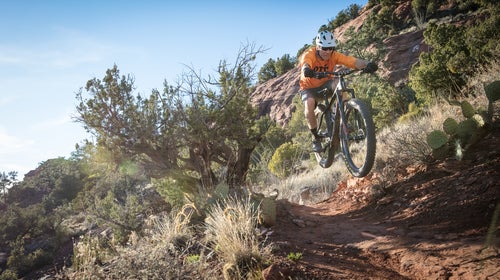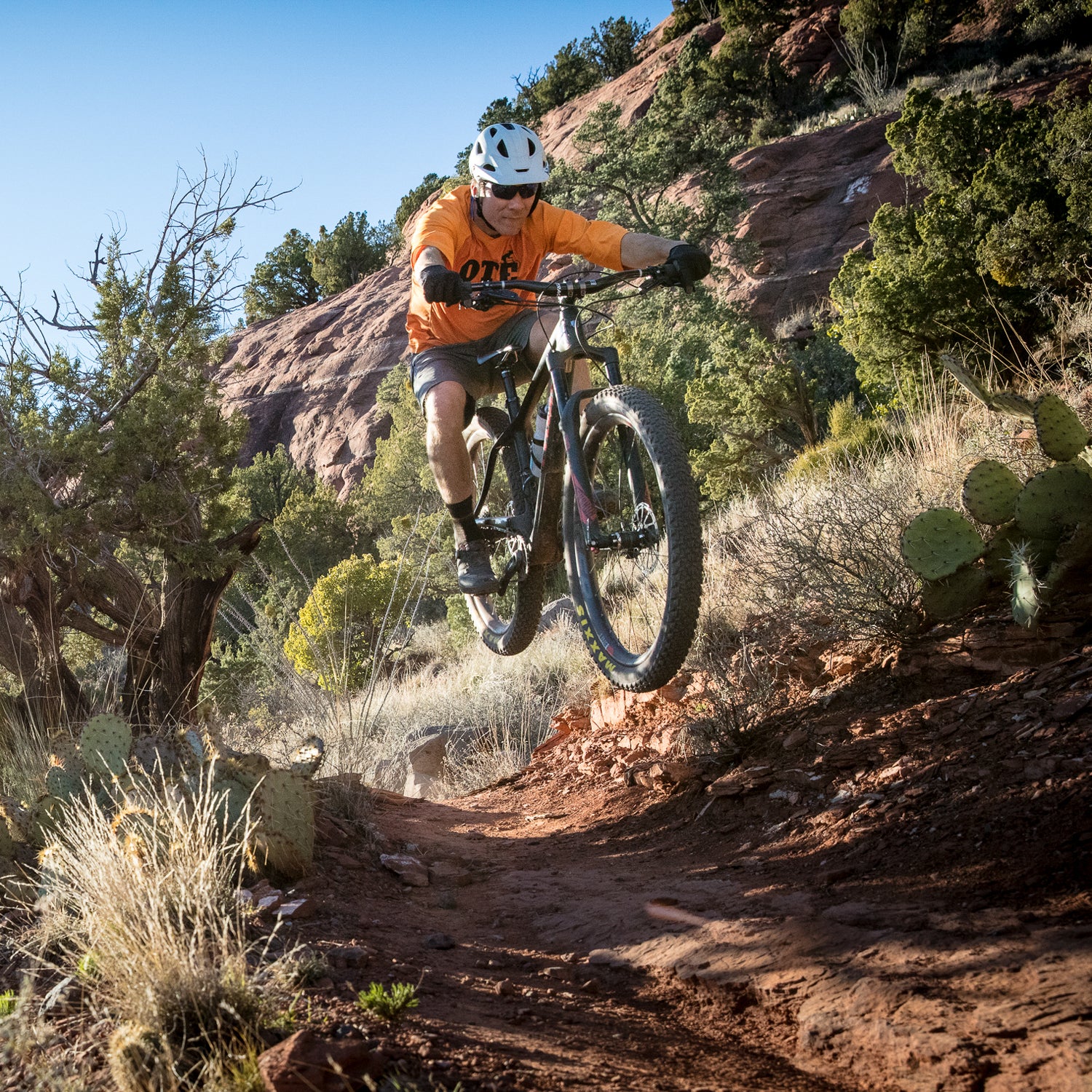What We Like: The only complaint we had with last year’s alloy Stache 9 was its weight. But now Trek has gone to a carbon frame and wheels and lopped off almost 2.5 pounds. Plus there’s added compliance.
What We Don’t: The low-profile Chupacabra tires roll fast but don’t have enough bite to keep up with the bike. And while the drivetrain is fine for what it is, a 1×12 with a 50-tooth granny would make it even better.
The Verdict: Anyone who complains that 29+ is too big and unwieldy has never ridden the . It’s a hardtail for the big-hit, high-speed, no-limits crew. I stand by my prediction that this bike will eventually make standard hardtails obsolete. And after another half-year on the upgrade, it’s clear that the Stache stacks up to many full-suspension rides as well. In short, it’s big fun.
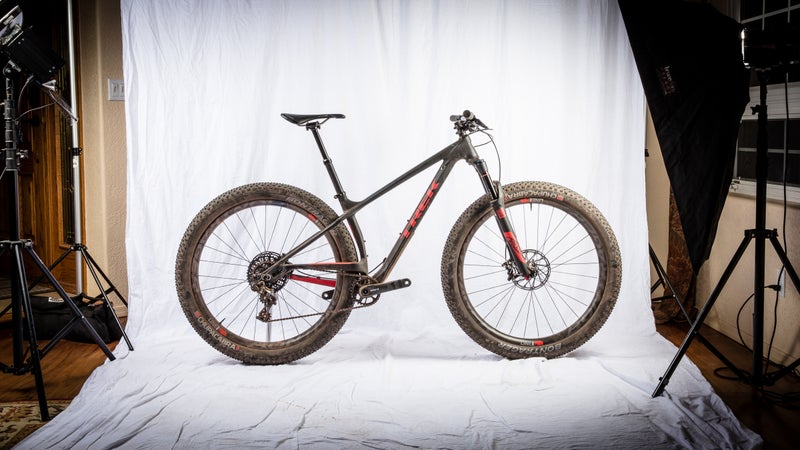
In case you’re still stymied by the nomenclature, 29+ puts three-inch-wide tires on 29-inch rims. Though there’s variance depending on brands and specs, these tires measure an inch or more taller than even the burliest 29er setup, some two inches taller than most 27.5+ setups, and 2.5 inches taller than normal 27.5 setups. Thanks to all that circumference, the wheels roll over objects with ease. The tires also have the largest contact patch of anything short of a full fatty. Historically, the drawbacks have been extra weight, additional rolling resistance, and a lack of maneuverability, though Trek has largely eliminated these issues through smart design and materials. The Stache, with its big wheels, is a dirt-gripping, rock-shredding, fast-rolling hardtail machine with few peers.
The Frame
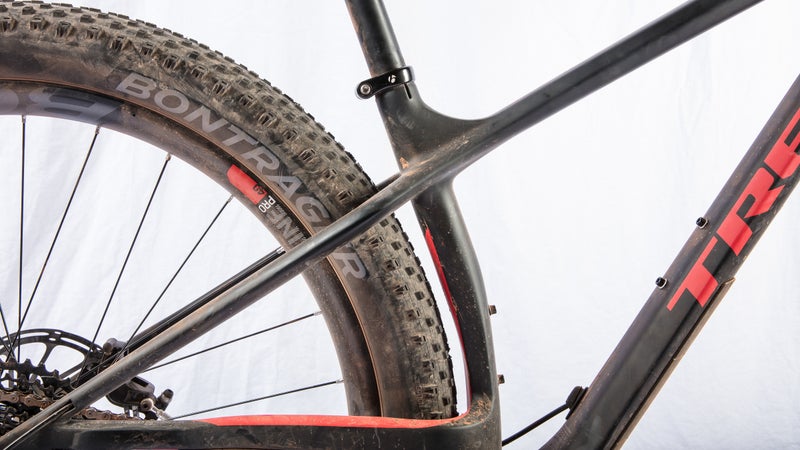
Trek kept the geometry from last year’s alloy Stache and upgraded to carbon. The raised drive-side chainstay, which allows for a short (420 millimeter) back end that both fits the big wheels and makes the bike snap forward when you stomp on it, looks classy here compared with some other brands’ gawky renditions. The arrangement means that the Stache can’t accept a front derailleur, but that’s less of an issue here, since the low overall weight means 11 or 12 gears is plenty. And though the Stache is a hardtail, the combination of big wheels, slack head-tube angle (68.4 degrees), and 120-millimeter fork makes for a bike that’s ready for the most raucous trails.
The Components
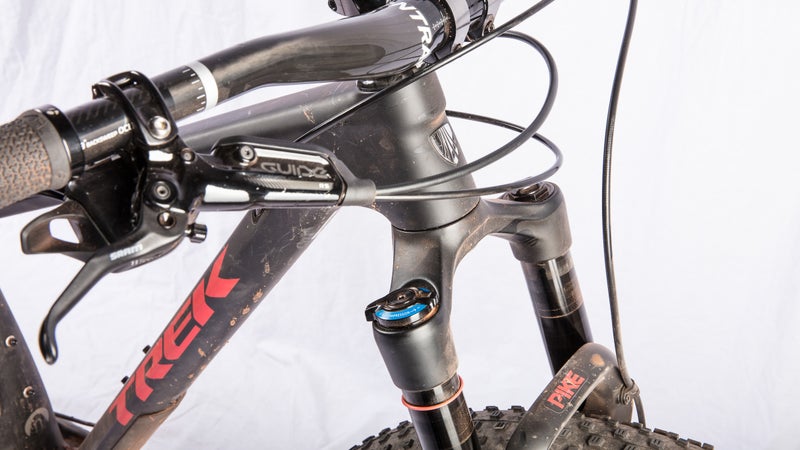
At $4,700, this bike is not cheap, but all the bits and pieces are high-quality, including SRAM Guide RS brakes, a SRAM X1 drivetrain, and a 120-millimeter RockShox Pike fork. For an ultimate build, we’d probably lean toward 1×12 gearing, with a 50-tooth ring to ease the sting on steeps. We also tried out a 140-millimeter fork, which some testers preferred for its handling on rowdy trails—an upgrade worth considering if you live somewhere like Sedona, Arizona. That said, the stock fork is plenty and more versatile.
Trek gets a special shout-out for its increasingly broad and sophisticated line of Bontrager components. The carbon wheels are what transform this bike: the 41-millimeter internal width allows lower pressure and tons of footprint on the tire, but the wheels are still zippy and light, courtesy of the carbon layup. The Stache is available in complete builds down to $2,100 and as a stand-alone frameset for $1,580. One smart option for those on a budget might be to buy a cheaper overall build, then upgrade to the Line Pro wheels, which retail for $1,200.
All the other Line Pro bits (stem, bars, grips) are nice, too, but the new Drop Line dropper seatpost is the standout. The action is smooth, and the head seems to avoid the loosening and side-to-side play so common with other brands.
The Ride
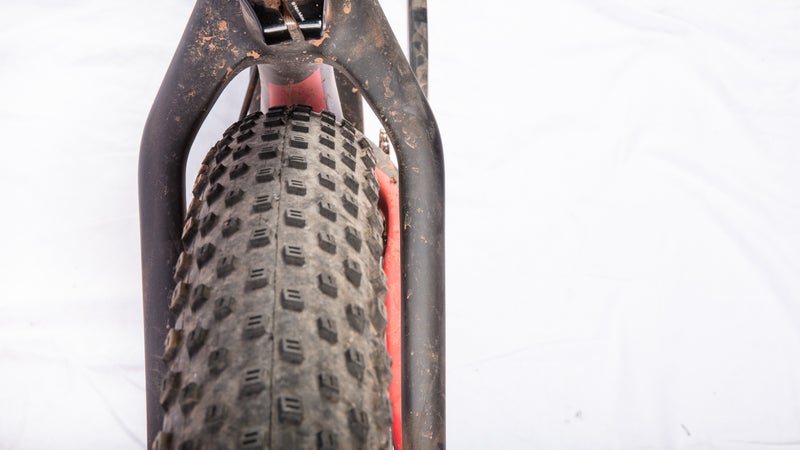
Everyone likes to refer to 29+ bikes as the monster trucks of the mountain world, but the Stache doesn’t ride big or awkwardly. Yes, the hubs are higher than on comparable bikes, but Trek engineered the fit so that you sit at the same level as on a normal 29er, so you really feel like you’re in the frame and not on top of it. Likewise, thanks to that tight rear end, accelerations are quick and immediate, and handling is surprisingly deft. Even on the sharpest switchbacks, I never felt too long or gawky to clear corners. There’s none of the pedal-strike issues you get with 27.5+, either.
As with all plus-size bikes, you do feel some extra heft in the wheels relative to a standard 29er or 27.5er. But in this case, it’s less about the weight (the full setup is about 70 grams per wheel heavier than comparable high-end 29ers we weighed) than the rolling resistance. Basically, you forgo a bit of efficiency for more traction. Which is to say that the Stache will never keep up with a flat-out race bike—but it’s not trying to be a XC machine. Rather, it’s a fun-hog that can go plenty fast.
Other than fitness racing, there’s basically nothing this bike can’t do. Freerider Cam McCaul . The tires’ huge contact patch and the oversize, inertia-busting wheels combine to create a bike that holds speed and traction. Here in the desert Southwest, where the trails are loose and scrabbly, we were amazed at how hard we could push into turns and down drops without the bike ever letting go. It’s true that the Chupacabra tires are a bit underbuilt for truly rough and rocky terrain, but once we switched to meatier tread (Maxxis Rekon+), the Stache was virtually unstoppable. (We’ve also heard rumors that Trek is working on a burlier plus-size tread.) With the bigger rubber, we blasted down choppy chutes, smashed off head-high drops, and kept pace with every full-suspension trail bike in the test.
The Competition
Lots of brands have gotten into the plus-size hardtail market in the past year or two, though most have gone the easier route of 27.5+. Bikes in this category, like the and , are great—with three-inch rubber adding confidence and comfort over skinnier-tired hardtails—but they can’t compete with the extra girth of 29+.
Before the whole 27.5+ craze, a few brands were making dedicated 29+ mountain bikes. The one that started it all, the , as well as its offshoot, the ., remain exceptional, affordable options, if a little dated by current standards. The Jones+ has proved to be an excellent touring and bikepacking machine, though the boutique price tag may deter some. Meanwhile, the Niner ROS 9+ and the are probably the bikes most comparable to the Stache. Both are excellent and well worth a look. But Trek has invested a lot into the Stache, and I believe that the bike’s refinement and pricing options make it the most capable in its class—and perhaps one of the most proficient on the entire market.
Bottom Line
A couple of years ago, I was an hour from the end of the Leadville 100 when a guy with a barrel chest who probably outweighed me by 80 pounds passed me like I was standing still. At the finish he was chugging two beers, one of which he graciously set down to go fetch another for me. That guy is pretty much the incarnation of the Stache. It’s a big, brawny, fun-loving bike with speed and agility that belie its stature. It’s not for everyone. But you’d be hard-pressed to find a more entertaining trail bike.
